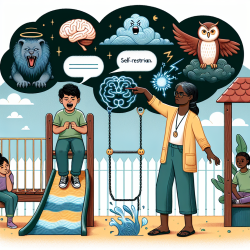Introduction
In the realm of speech-language pathology and child development, understanding the intricate dynamics of emotion regulation and inhibitory control is paramount. A recent study titled "Clarifying the Synergistic Effects of Emotion Dysregulation and Inhibitory Control on Physical Aggression" by Bounoua et al. (2022) provides valuable insights into how these factors interact and influence aggressive behaviors. This blog aims to distill the findings of this study and offer practical applications for practitioners seeking to enhance their skills and outcomes for children.
Key Findings
The study, conducted with a high-risk community sample of 206 adults, explored the unique and interactive effects of emotional dysregulation and inhibitory control on physical aggression. The researchers utilized various methods, including self-report measures, neuropsychological testing, and neuroanatomical scans, to assess participants.
Key findings include:
- The interplay between emotional dysregulation and inhibitory control significantly predicts physical aggression, surpassing the effects of each factor alone.
- Cortical thickness in the right superior and caudal middle frontal gyrus was linked to the interaction between emotion regulation and inhibitory control.
- The superior frontal gyrus's thickness mediated the relationship between emotion dysregulation and physical aggression at low inhibitory control levels.
Practical Applications for Practitioners
For practitioners in speech-language pathology and related fields, these findings underscore the importance of addressing both emotional regulation and inhibitory control in therapeutic interventions. Here are some practical applications:
- Integrated Interventions: Develop interventions that simultaneously target emotion regulation and inhibitory control. Techniques such as cognitive-behavioral therapy (CBT) can be adapted to focus on these areas, providing children with tools to manage emotions and impulses effectively.
- Neuroanatomical Awareness: Understanding the role of specific brain regions, such as the superior frontal gyrus, can inform the development of targeted therapies. Practitioners can collaborate with neuropsychologists to create comprehensive treatment plans that consider neuroanatomical factors.
- Data-Driven Decision Making: Utilize data from assessments and progress monitoring to tailor interventions. Regularly evaluating the effectiveness of strategies in improving emotion regulation and inhibitory control can lead to more personalized and effective therapy.
Encouraging Further Research
While the study provides significant insights, it also opens avenues for further research. Practitioners are encouraged to explore how these findings can be applied to different populations, such as children with developmental disorders or those in diverse cultural contexts. Collaborating with researchers to conduct studies that build on these findings can contribute to a deeper understanding of the mechanisms underlying emotion regulation and aggression.
Conclusion
The research by Bounoua et al. highlights the critical interplay between emotion dysregulation and inhibitory control in predicting aggressive behaviors. By integrating these insights into practice, speech-language pathologists and other practitioners can enhance their therapeutic approaches, ultimately leading to better outcomes for children.
To read the original research paper, please follow this link: Clarifying the synergistic effects of emotion dysregulation and inhibitory control on physical aggression.










